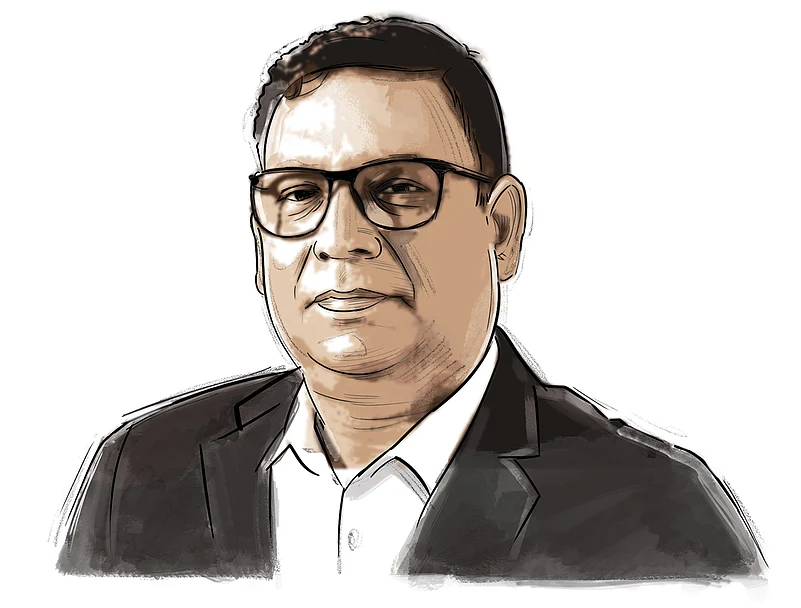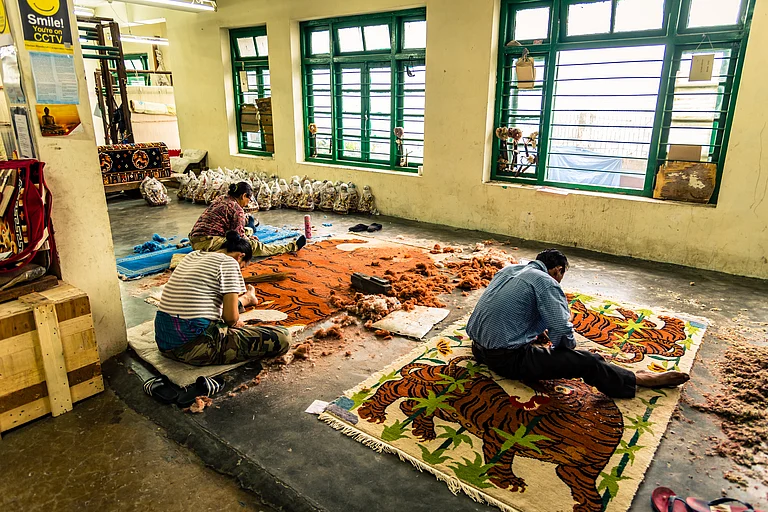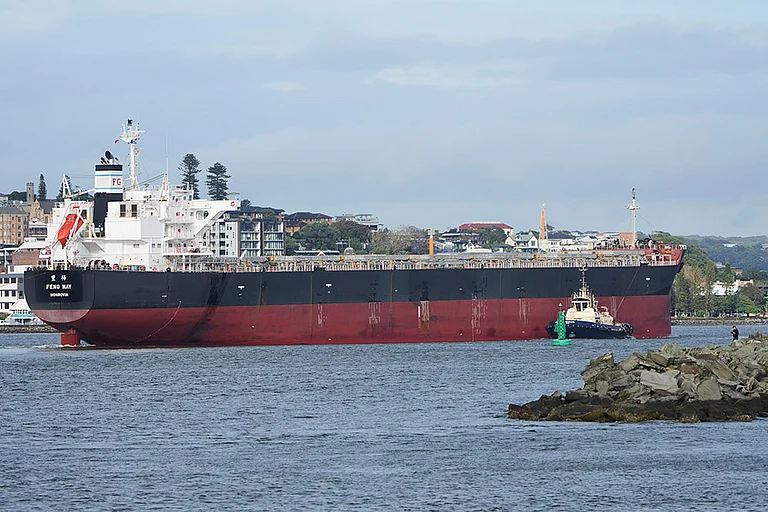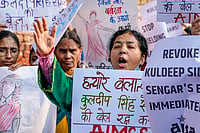
Tariffs of 50 per cent on India's exports to the US kick in on 27 August.
The 50 per cent tariff includes a 25 per cent penalty imposed by the US.
It will impact small and micro sector in India, but there are ways out.
On the day before a sweeping set of new tariffs—up to 50 per cent—kicked in on a broad range of Indian exports to the United States, Anil Bhardwaj, Secretary General of the Federation of Indian Micro and Small and Medium Enterprises (FISME), unpacks what this moment could mean for India’s MSME exporters. Representing thousands of small manufacturers across sectors, FISME is closely tracking how US protectionism is reshaping trade in India and beyond.
Bhardwaj warns that the real impact of the tariffs imposed on India will not be immediate, but by the next export cycle, key sectors like garments, handicrafts, durries and leather exporters, will threaten Indian competitiveness. He says now is the time to begin diversifying beyond the US market and invest in modernising MSMEs.
This is crucial, for in recent years, Indian MSMEs have contributed close to half (45 per cent) of the country’s total exports, while supporting a bulk of the workforce. The exports they are behind are high in value, well over Rs 4 lakh crore (US$ 140 billion-plus). Edited excerpts from a phone interview with Outlook.
Q. What immediate impact are you expecting on Indian exports after the US tariff hike, which kicks in on August 27?
There will be a noticeable shift, in roughly six months from now. At the moment, many buyers in the United States had placed orders with Indian suppliers in advance. Therefore, the next one or two months won’t show much impact. The real test will come in six months, during the post-monsoon export season that feeds into the Christmas cycle of new export orders to the US. That will be the period to watch out for.
In certain sectors, especially garments, the impact will be more evident, as it is a price-sensitive sector.
Q. What do we mean when we say ‘price-sensitive’?
Price-sensitive means that in low-end segments, even a 10-15 per cent cost increase [due to additional tariffs] can make buyers look for other suppliers. For example, if Bangladesh can offer a basic T-shirt at US $1 and India’s price is US $1.25, buyers won’t think twice before shifting away.
Wedding gowns, on the other hand, are less price-sensitive. That’s because the wedding market on the whole is less sensitive to shifts in prices. A $1,000 wedding gown, if it costs $1,100 tomorrow, that won’t deter buyers. But unfortunately, India isn’t in that high-end game—that space is dominated by China, Korea and Vietnam.
In the mid-segment—like coats and sweaters—Bangladesh is ahead of India, and that is partly because they import wool, which ends up being cheaper for them. In India, we consume a large part of our domestic wool supply, so we do not have a large share of those exports at all. You will hardly find Indian woollen garments on sale in the European markets, for instance, because a lot of the consumption is domestic, within India.
Q. But this is not only about raw material costs, is it?
No, it’s also about product design and innovation, across some sectors. Take wool blends within the textile export market. You will have noticed that there are a lot of new clothing items that combine wool with viscose or other man-made fibers. This makes clothes cheaper, glossier, easier to maintain and more durable. You don’t need to iron many of these garments, you also don’t have to dry clean them, so they are easy to maintain and hardy and also easy to innovate designs and patterns with. But India’s manmade fibre sector is hamstrung by monopolies and high prices of raw materials and machinery.
The oddity is that our fibre and steel sectors are both controlled by few companies, which drives up our input costs. As a result, even when we blend manmade fibres with, say, fine wool, we are still 20-30 per cent more expensive than similar products made in China.
Jewellery is another area where we will feel the pinch of the Trump tariffs. India’s readymade jewellery faces stiff competition from Thailand, Italy and Turkey. In Turkey, for example, they use advanced manufacturing techniques and machines to create very fine jewellery that comes at close to half the cost of what we can make.
Look, in India, jewellery manufacturing is still largely manual, with coarser machines and MSMEs supplying to large brands like Kalyan or Tata or anybody else. What I mean is, the large branded jewellery retailers are also reliant on local suppliers who use less advanced technologies. They buy from the small-sector jewellery makers, and resell it. They have no factories. If they set up factories, they can sell abroad…
Since the labour costs in the sector are far lower in India than in the other countries, the branded jewellers prefer to use those MSME suppliers, even moving towards the smallest makers as their suppliers, instead of importing machines. This is also because our local demand for gold and jewellery is quite high—we have a big domestic market.
That said, to compete globally, we need investment in high-tech jewellery factories. We need more manufacturing based on the latest methods and techniques. However, to set up such competitive manufacturing unites requires scale.
Q. What kind of scale?
One needs at least Rs 1,000 crore, or at least Rs 500 crore to set up such units. Right now, most MSMEs in the readymade jewellery sector are operating out of Rs 50-crore units, or much smaller. So, there will be an impact from other destinations that also manufacture jewellery at lower purity—16, 17—rather than the purer 20-carat or above items Indians prefer for gold jewellery. The designs from Turkey, even Italy, are also more delicate and versatile, whereas Indian jewellery designs are unique for being handmade or less machinelike. That said, this is a sector with high demand within India, we should not forget…
On the flip side, we have other sectors, such as auto component exporters, who are be less affected in the short term by the tariff changes. These items are often part of global supply chains and each exported item from India may be contributing just a small percentage to the final product. Say, one auto part contributes 1 per cent of the total cost of a car made in the US. In that case, if the cost rises by 10 per cent, importing companies may absorb the hit to avoid disrupting their supply chains, which take a long time to build.
They won’t disturb supply chains immediately—the question is how long they would be willing to bear that additional cost, and how far we will be able to reduce our costs through improving productivity or reducing our manufacturing costs. If we can reduce raw material costs in India, by tackling monopolies and so on, then we can, to a large extent, blunt the impact of these tariffs.
Q. What do Indian MSMEs want from the Indian government at this point in time?
They’re starting to ask the government to explore new markets for Indian exports. The US and European Union may be erecting tariff and non-tariff barriers against countries like China. However, for India, and for its MSMEs, the rest of the world remains a largely untapped opportunity. We hardly have a presence in many parts of the world.
Look at it this way, if China’s exports to the US and EU make up 40 per cent of its total exports, that means it is still exporting 60 per cent to other parts of the world. So, they are going to orient their energies to the rest of the world, the 60 per cent. We can also reduce the cost of finance for MSMEs, especially for technological upgradation. I think we can expect such announcements soon. So far, we had been waiting to see if there would be [relief measures] announced or not.
We do expect some scheme to reduce export finance costs, technological upgradation costs, and so on, for MSMEs…You see, until the tariffs are actually raised, they remain in the realm of speculation—it is only now that it has become a reality. And we must remember also that when we are dealing with a bully, if he gets his way in one area, he pushes for the same in other areas, keeps pushing you. You do reach a point when you stand up before a bully. Maybe the time has come.
So same is the case with us in India also. If we are unable to reach our products to the US, then the rest of the world is still there, which we must explore. Our potential export links to Africa, Latin America, Australia and the Middle East markets have not been tapped. Our members are now asking for the government to help them access these markets through trade fairs, through compliances for standards in each region and building market linkages. Maybe that’s what our members are saying to the government—help us explore these new markets.
Q. But these are all long-term things, which will take effect after longer than a year.
Yes, true, in trade things take time. They don’t change immediately.
Q. Are the tariffs clogging the export system, causing delays and roadblocks, extra paperwork?
It is not that complicated—the tariff will go up, that’s about it. But let us face it: the tariff had been raised already earlier this year. What’s happened now is that a penalty has been imposed.
Q. It is being recorded in the paperwork as a penalty?
Yes. The 25 per cent imposed earlier this year was a tariff. This additional 25 per cent is a penalty.
Q. Can India challenge the US tariffs at the WTO?
Technically yes, but practically, no. The US is playing the biggest boss in this entire tariff issue. It wants us to do many things, including with respect to our trade and relations with Russia. Before this, there was recourse in the WTO. But the US President is completely disobeying stablished rules. Disobeying may be a mild word, for he has bulldozed norms. WTO's dispute resolution mechanism has been made defunct. The US has even stopped funding it.
So, while the US’s tariffs clearly violate WTO norms, like the Most Favoured Nation (MFN) rule, as per which you cannot unilaterally impose tariffs on any country, there’s really no recourse. While the reality is that the US, under Trump, is bulldozing global trade norms, we cannot force him to change his ways. That’s why the world is entering into a warlike situation, for he is fighting not just us, but everyone.
Q. You mean a global trade war is being sparked?
Yes, that is right.
Q. How worried is the small-scale and micro industry right now on a scale of 1 to 10?
Sectors like garments, leather, carpets, parts and components of automobile sectors, and handicrafts, and shrimp are the most impacted. These sectors are highly export-dependent and those exports are heavily tied to the US market and the manufacturers are very often in the MSME sector. Those in the MSME sector, who are also dependent on the US for importing their goods and produce, are likely to be impacted.
But beyond that, the nervousness is more measured. There’s resilience in sectors like pharma and services, which haven’t been targeted yet.
Q. Can US consumers and companies push back against the tariffs? Will the US be able to find alternative markets?
It is not as if shifting to new markets and suppliers will be very easy for US buyers, no. And yes, eventually, these tariffs will raise prices in the US. Inflation will follow. Consumers will feel the pinch in the short term—and pressure will build, especially ahead of elections. There will be a hungama there, too, over rising prices.
And let’s not forget—it’s not easy to replace Indian suppliers overnight. Vietnam’s labour costs are higher. So, even though the US has imposed lower tariff rates on Vietnam, it won’t be so easy to shift away. Bangladesh has its own issues. Shifting supply chains is not going to be simple or quick.
Q. Do you also hear of US importers preparing to or thinking about putting pressure on their government, perhaps when the time is right, when Trump might be in a mood to listen?
I think this will happen, because that pressure will not only come from the importing companies, but from the consumers, the US public. And the public has only one primary way of expressing itself—through elections. That means the next mid-term election in the US, in the middle of next year, then, I believe, the US administration will be a bit of a jolt from public dissatisfaction.
Q: Is the Indian government taking measures for supporting MSMEs?
They’re aware. There are active discussions around reducing the cost of raw materials, lowering export finance interest rates and supporting technological upgrades.
Schemes are likely to be announced soon; we’ve been hearing that. But implementation speed and scale will determine how much relief actually reaches MSMEs.




























